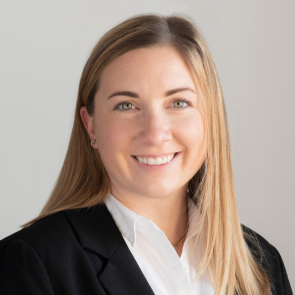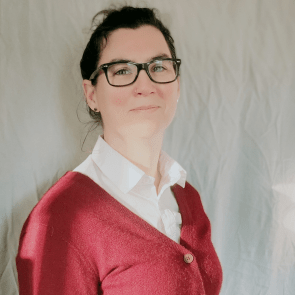From Blueprint to Open Water: Crowley’s People Innovate to Create the eWolf
Earlier this year, Crowley’s engineering services team celebrated a significant milestone for the industry and their careers. After diligent conceptualizing, designing and collaboration, Crowley completed and began operations for a U.S.-first: the fully electric, zero-emissions tugboat, the eWolf, specifically designed for the Port of San Diego.
This tug represents a milestone in maritime innovation and a bold leap into all-electric operations. As the first electric tug, the eWolf is set to offset the emissions equivalent of over 350,000 gallons of motor vehicle gas during its first 10 years of operations.
For these engineers, project managers and technicians, the eWolf was another example of Crowley driving innovation and sustainable practices, and gives its employees an opportunity to make an impact in their careers and industry
After working on the eWolf, some of the project’s contributors, Eileen Tausch, Ryan Hogge and Kelly Williams Hooper, reflected on being a part of the team that pioneered this industry-first vessel. Like any significant milestone, their unique project experience was not without its successes and challenges overcome.
eWolf Innovation and Collaboration Propels Careers
As the project moved through different phases, teams had to adapt, learn on the fly and prioritize collaboration. For Kelly Williams Hooper, a hydrostatics and stability engineer who oversaw the stability and weight control considerations throughout the project, communication was more important than ever before.
“Crowley is proud to be an employer that champions new frontiers and encourages its people to reach for broader horizons. It was critical that everyone was communicating effectively and knew what was going on in the project in real-time and as changes were made,” explained Williams Hooper. “Since so much of this project was new, a single change had a butterfly effect that impacted everyone’s work. It took a lot of discipline as a group to solve these problems collaboratively and ensure we weren’t operating in silos, which just wouldn’t have been possible with this project.”
Silos were broken down within Crowley and between vendors and port authorities. The team had the added difficulty of handling project communications virtually, so frequent cross-functional communication became crucial.
“We had to think and work beyond our typical teams and checkpoints. What started as a small group expanded to include everyone that needed to be involved,” said Williams Hooper.
Eileen Tausch, a senior electrical engineer and research and development team member, worked on designs collaboratively with the mariners and Crowley shoreside staff who would ultimately manage and operate the vessel.
“My involvement with the eWolf was really in the actual rollout of the vessel in San Diego, transitioning from the construction phase into operations by working with the crew and understanding and analyzing the data from the vessel’s operations,” said Tausch.
With the user experience in mind, vessel designers at Crowley optimize their work by collaborating directly with the folks impacted by design and engineering decisions.
“The opportunity for interaction with the folks on the ground is a particularly special opportunity you don’t get everywhere,” said Tausch. “The industry is changing quickly, and this is an exciting place to be as we start future-proofing vessels — like the eWolf — to meet the moment.”
Ryan Hogge, a director of projects, also worked with the mariners who would operate the vessel. Due to its electric functions, the eWolf was a complex project to construct that required a lot of new and different onboard equipment. As a result, everything had to be precisely engineered without sacrificing the safety of the mariners operating the vessel, nor their onboard experience.
“The key was getting the right people involved at the right time and finding the right answers,” began Hogge. “When thinking about the mariner’s experience on the vessel, we looked a lot at how airline’s deploy structure and technology to drive a positive experience for their clients. In our case, our clients were our mariners.”
Engineering New Technologies for the Industry
The eWolf project provided significant personal and professional opportunities for those who worked on it. It fostered an environment where innovation thrived and experimentation was encouraged. The knowledge and expertise Crowley employees gained from the eWolf project left them eager to tackle similar challenges on future projects. This experience highlighted Crowley’s commitment to fostering career advancement through cutting-edge projects and cross-functional collaboration.
According to Hogge, the experiences and lessons he gained from the eWolf are already being applied directly to his next build at Crowley.
“As I’ve progressed through my career in Crowley, I’ve brought forward the knowledge I’ve gained from each of my projects and applied it to the next,” said Hogge.

Tausch’s success with the eWolf has inspired her to consider other innovations in the industry related to electrification and sustainability.
“It expands the type of projects we can look at and how we think about them,” said Tausch. “One of the areas that I’m interested in is the charging station built specifically for the eWolf and determining how we can use this model on other projects in the future. We built a lot of new infrastructure for this vessel, so we need to figure out how we can use that infrastructure to diversify and continue to advance the industry in functions like cargo handling equipment, drayage trucks in the ports or commercial trucks and electric vehicles.”
Williams Hooper reflected on the importance and responsibility of being the first to attempt and succeed in launching a fully electric tug vessel in the U.S. The project was the first time a nautical engineering team used such a significant number of sustainable materials in outfitting a single vessel.
Careers in Cleaner Technologies
As the maritime industry shifts its mentality to cleaner technologies, having experience using these sustainable materials and proving they can be used efficiently is a huge advantage for Williams Hooper and her fellow engineers.
“I think being a group that innovates, creates change and steps forward involves a lot of courage and embracing of risk,” said Williams Hooper. “A lot of the eWolf technology was unproven and not every company is ready to bet on it. Our teams are very proud to be the first to do so in the industry and set the standard that it can be done. The innovation is worth the investment.”
For Tausch and many others, the project aligned with the career ambitions that brought them to Crowley.
“The eWolf and Crowley’s general commitment to innovation is why I joined the company. It’s a huge opportunity to be on-site and see the vessel go from concept through construction to delivery,” said Tausch. “Other places are still working on the feasibility of these types of projects, but at Crowley, I could be engaged with the vessel from my first day on the project to when it entered operations.”
The eWolf marks an essential milestone in the future of sustainable maritime technology. The expertise brought to Crowley and its people will go beyond this project and support creating a sustainable future that employees are eager to shape.
“Thankfully, alternative energy solutions are here to stay, and getting to be involved in such a landmark project is a tremendous opportunity,” said Williams Hooper. “We have a long way to go, but it is an exciting time to design hybrid and electric maritime solutions.”
Crowley offers rewarding maritime careers for college graduates and others looking to join a company that prioritizes safety and innovation while providing competitive wages, opportunities to advance and the choice to join a hard-working team building a sustainable future. Learn more about maritime jobs, including becoming a seaman or a tankerman.
OTHER STORIES THAT MAY INTEREST YOU:





